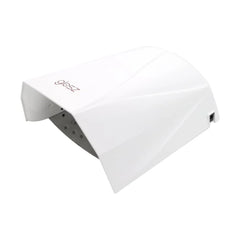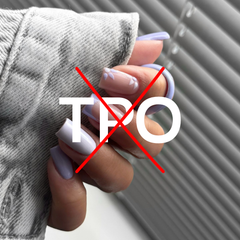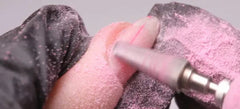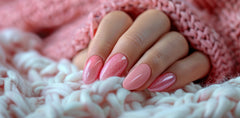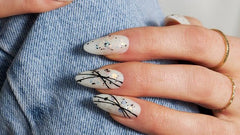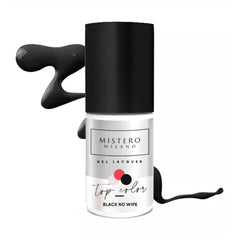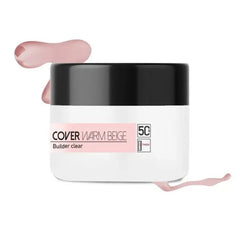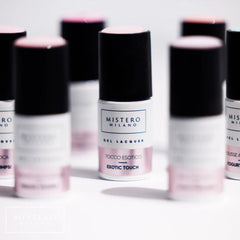Curing of nail products
Amber D'Halluin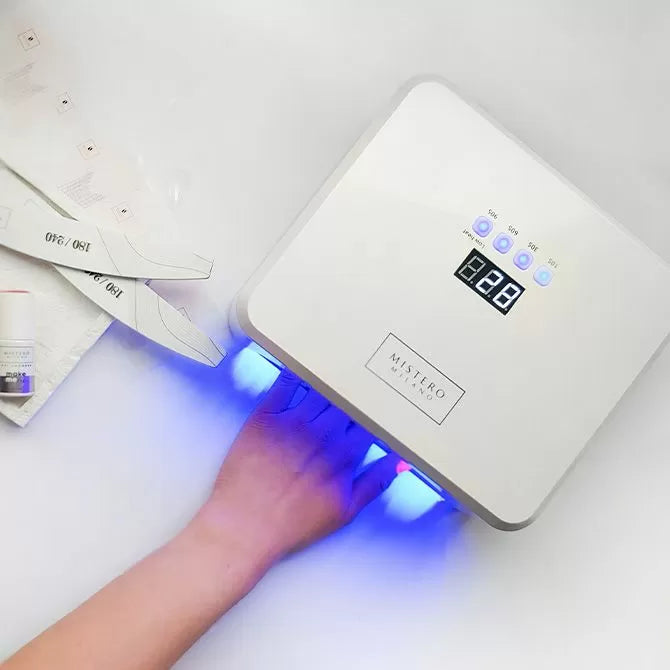
1. Difference between curing for UV products (gel, gel polish, etc.) and acrylic
The biggest difference in curing between UV products and acrylic is that acrylic cures without an external energy source, while UV products require a UV source. The principle behind the curing remains the same. Long chains are made from short molecular chains, which causes the product to start curing. With UV nail products longer chains are already present as standard than with acrylic products. For this reason, acrylic products do not harden in a weak UV source such as a nail lamp , but you need a chemical reaction to make the molecule chains long enough.
For UV products such as gel , gel polish and polygel the degree of curing depends on the curing time and the type of lamp. It is therefore important to only use a lamp that the manufacturer recommends and to follow the curing times stated on the product. If you cure UV products poorly, this can lead to a contact allergy, which you should avoid at all times.
Bee products for acrylic nails the hardening is caused by mixing acrylic liquid (monomers) and acrylic powder (polymers). The degree of curing therefore depends on the mixing ratio. So always make sure that your acrylic bead is never too wet or too dry. In addition, you should never use acrylic liquid and powder from different brands together. The products are not developed for each other, which greatly increases the chance of incorrect curing.
2. The different phases during curing
The curing process is also known as polymerizing the nail product. Curing a product is done by molecules that bond together to form long chains. As the curing process progresses, these chains become longer. The curing of artificial nails consists of four phases , each phase is explained further below.
- Phase one is when the product sets and starts to thicken, this happens after 10-15 seconds. When you place your artificial nails under the lamp, about 25% of the reactive molecules will link together to create short chains. At this stage, the nail product will be about ¼ cured.
- Phase two is when at least 50% of the artificial nail has hardened. When your artificial nail is 50% hardened, it is basically hard enough to file into shape. It is important to know that the nails are not hardened enough. Insufficiently hardened nails are one of the main causes for developing a contact allergy .
- Stage three is when the product is 90% cured. It is not necessary for the nail product to be 100% cured, 90% is enough for a strong and durable manicure. You cannot know or feel when your product is cured enough, so it is important to always follow the instructions provided by the manufacturer.
- Phase four occurs when the client leaves your nail salon. The artificial nails continue to cure once home. The curing process is much slower but the product will cure another 5-7%.
3. Can curing be interrupted?
Interrupting the curing process has no negative effect on the curing of artificial nails. If you remove your artificial nails from under a UV source, the curing process will continue at a very slow pace. When you put the artificial nail under a UV lamp again, the curing process will be accelerated again.
It is important to know that the curing process never stops, even without a UV source. In addition to a nail lamp, other UV rays can also accelerate the curing process, such as sunlight or tanning beds. Over time, this causes hard, brittle or discolored artificial nails.
A good nail product is designed to slow down the hardening process so that the artificial nails remain in good condition for up to 16 weeks. With a product that has not been researched much, you will notice that the nails will already discolour or become brittle after a few weeks. The lifespan of 16 weeks is not a coincidence. It takes an average of 16 weeks for your nail to grow out completely and therefore for all the artificial nail mass to be removed.
4. Is it possible to over-cure artificial nails?
Artificial nails can be over-hardened due to several factors. Over-hardening artificial nails causes damage to your nails, such as nail infections, discoloration, lifting, breaking and cracking. After removing the artificial nail, you will notice that the natural nail is more brittle and more susceptible to damage than normal.
Excessive curing is sometimes caused by unwanted UV exposure. This is usually due to natural sunlight or tanning beds. If your artificial nails are exposed to UV rays for a long time, this causes them to become brittle and lose their flexibility, which is detrimental to their durability. We often also see clear discoloration if the client has used a tanning bed.
You can also cause excessive curing via a UV or LED lamp. Curing the artificial nails in the lamp for too long is the most common problem here. You must therefore always follow the correct curing times. In addition, an incorrect lamp can also cause problems. The UV energy was based on different wavelengths. It is therefore better to use the UV lamp recommended by the manufacturer. The curing times according to the different lamps can be found on the label of the product or on the website of the manufacturer.
5. Why do some UV products have an adhesive layer?
The adhesive layer on top of a UV curing product is also called the inhibition layer (inhabitation layer). Often this is also called the dispersion layer, but this is a misnomer. Dispersion is used to express the spreading of something and is therefore not applicable to the adhesive layer of a UV product.
As explained earlier, UV products harden by forming long chains under the influence of UV energy. Due to the presence of oxygen in the air, the formation of long chains will be blocked at the top of the nail. This gives you a half-hardened layer (inhibition layer) that you can easily remove from the artificial nail. The UV product under the inhibition layer is fully hardened because there is no oxygen present there.
The curing speed of a UV product has an influence on the thickness of the inhibition layer. The faster the product cures, the less time the oxygen will have to block the curing process. Using the wrong UV lamp (not powerful enough or wrong wavelength) will cause the curing time to be delayed, which will make the inhibition layer thicker. In addition, incorrect placement of the hand in a nail lamp also has a negative influence on the adhesive layer.
Uncured UV products are one of the main causes of developing a contact allergy. So always make sure you cure the products as prescribed by the manufacturer. It is important that you pay attention to removing the sticky layer, so you avoid unwanted skin contact with uncured nail products.
6. Can UV products be cured under a work lamp?
In some cases, a work lamp will harden UV products. Especially the full spectrum lamps are the most dangerous. These lamps imitate natural sunlight and can be compared to a weak UV nail lamp. These lamps can emit too much UV, causing the UV products to harden.
To know if a table lamp cures the UV products, you can apply a small amount of the nail product to a tip or other object. Place the tip close to your light source for half an hour. If you do not notice any thickening, the light source will not cure the product.
7. Heat spike during curing of nail products
If the nail product becomes warm during application, we call this exothermic. The warming up is not a problem in itself and is often even considered normal. The heat is created by the hardening or polymerization of the artificial nail. If the artificial nail becomes too hot, this can be painful for your client. In addition to the uncomfortable feeling, a high heat peak can lead to infections or damage to the nail bed ( onycholysis ).
The curing process is millions of small invisible molecules that continuously join together to form multiple long curing chains. When two molecules react to join together, a very small amount of heat is released, but this is very limited so it is unnoticeable. When curing artificial nails, these are millions of molecules that connect to each other at the same time. Combine the heat development that is created by all these reactions and it quickly becomes very hot. The more nail product you apply to the nail, the more molecules will react. The heat development with too thick artificial nails is therefore much greater than desired.
Heat peaks also occur during the curing of gels by using the wrong nail lamp. The faster a product cures, the more heat is released in the same period. If you have to distribute a certain amount of heat over 2 minutes or the same amount of heat over 30 seconds, you will quickly feel that a fast curing will cause more heat development.
Using acrylic liquid (monomer) in combination with the wrong acrylic powder (polymer) can cause the nail product to overheat. It is very important to only combine acrylic powders with acrylic liquid that is recommended by the manufacturer. Also with acrylic products, fast-drying acrylic causes more heat.
Heat peaks are more sensitive when the nail bed is damaged. A damaged nail bed has many causes, such as filing too aggressively. Filing causes the nail to become much thinner, which greatly reduces the insulating function. The heat that is generated during the hardening of the nail will pass through the nail much faster and damage the nail bed. The friction that is generated by aggressive filing also burns the nail bed locally, making your nail bed much more sensitive. When small amounts of heat are applied to your nail afterwards, this still causes severe pain for the customer.

